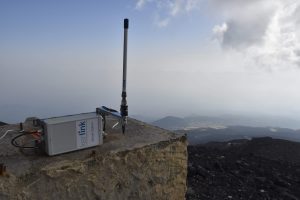26.02.2020 | Kerlink Gateway Technology Powering Internet of Things Radon-Monitoring System on Europe’s Most Active Volcano, Mount Etna

Thorigné-Fouillard, France – Feb. 26, 2020, 6:00 pm CET – In a novel example of the broad applications of LoRaWAN Internet of Things (IoT) connectivity, Kerlink (AKLK – FR0013156007), a specialist in solutions dedicated to the IoT, today announced its Wirnet gateway is powering a radon-sensing project on Europe’s most active volcano, Mount Etna.
The recently deployed network linking Mount Etna on the east coast of Sicily to scientists in Clermont-Ferrand, France, 1,200 kilometers away, transmits radon measurement data, which helps scientists monitor activity of the volcano. Radon is a natural radioactive element found in high concentrations near volcanoes and uranium deposits and is one of the potential precursors of volcanic eruptions.
For many years, scientists have measured radon in the soil of the 3,300m-high Etna, which required on-site visits. A new system of autonomous radon sensors, designed and deployed by French scientists in Clermont-Ferrand and supported by the LoRaWAN network, remotely and continuously measures radon in plumes of volcanic gas. The system also allows measuring radon emissions near the top of the volcano, an area that was out of reach for soil samples in the winter.
A Kerlink Wirnet Station at the Etna site collects data from LoRaWAN nodes, which are connected to radon and meteorological sensors, and transmits the information via its embedded 3G backhaul, to the LoRa server at Clermont-Ferrand in the French National Institute of Nuclear and Particle Physics, where scientists analyze the data.
“The radon sensors that send their data in near-real time, year-round, to the LoRaWAN server in Clermont-Ferrand give volcanologists an unprecedented picture of what is happening at Etna,” said Laurent Royer, of Laboratoire de Physique de Clermont. This lab is a joint research unit of Clermont-Auvergne University (UCA), and the French National Center for Scientific Research (CNRS), which support the Etna project.
“This project not only highlights the diverse and vital concrete use cases enabled by LoRaWAN networks, but also Kerlink’s position as a leading supplier of robust, high-performing gateways for those use cases,” said Stéphane Dejean, Kerlink CMO. “Wirnet gateways are enabling and powering multiple IoT projects in some of the most challenging and demanding environments on Earth. Our teams are very proud to be able to contribute to this type of scientific research-and-prevention project.”
The volcanic research project received funding from the I-SITE Clermont CAP20-25 project and the European Regional Development Fund (FEDER), in partnership with Italian Institute for Geophysics and Volcanology (INGV).


